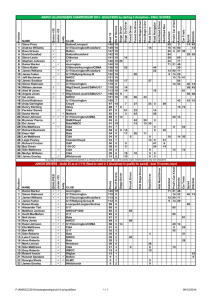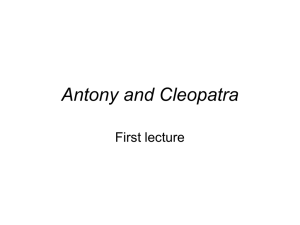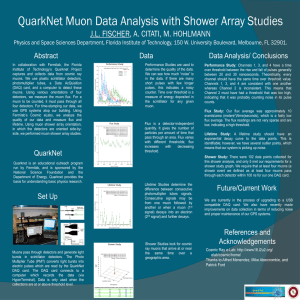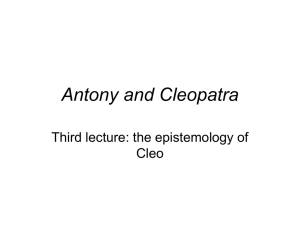Particle Detectors
advertisement
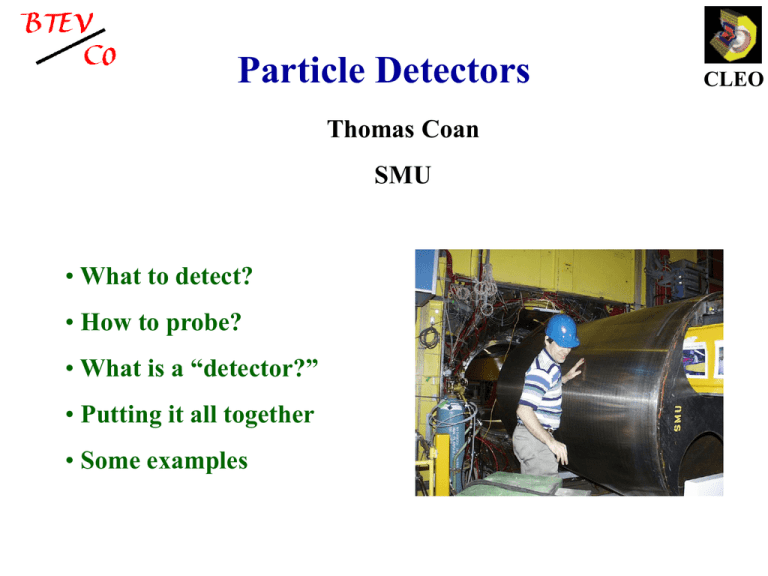
Particle Detectors Thomas Coan SMU • What to detect? • How to probe? • What is a “detector?” • Putting it all together • Some examples CLEO Thomas Coan/SMU Particle Properties • mass • lifetime • electric charge • ”spin” Quarknet 2001 CLEO Thomas Coan/SMU Quarknet 2001 General Idea of Colliding Particle Experiments • Collide probe particles with target • Detect particles from collision • Interpret results CLEO Thomas Coan/SMU Quarknet 2001 Early Particle Physics Experiment Ernest Rutherford 1909 Set-up: Interpretation: CLEO Thomas Coan/SMU Quarknet 2001 How do we “shoot” probe particles? Acquire some probe particles Accelerate the probe particles Final speed c Steer and aim the probe particles CLEO Thomas Coan/SMU Quarknet 2001 Accelerator Types CLEO Circular Thomas Coan/SMU Accelerator Types Linear Quarknet 2001 CLEO Thomas Coan/SMU Target Types Colliding beam Fixed target Quarknet 2001 CLEO Thomas Coan/SMU Quarknet 2001 Wave Nature of Particles Waves interfere: Electron diffraction: particle as wave CLEO Thomas Coan/SMU Quarknet 2001 Why use higher and higher energies? CLEO = h/p The more energetic the probe, the finer the accessible detail Thomas Coan/SMU Quarknet 2001 Collide CLEO Thomas Coan/SMU Quarknet 2001 Trajectory measurement CLEO • Charged particle • Noble “fill gas” • Electric field • Drifting ionized e“Drift time” DOCA Magnetic field curves trajectory “curvature” 1/p Thomas Coan/SMU Quarknet 2001 CLEO Drift Chamber CLEO 31 stereo layers 8100 cells 16 axial layers 1696 cells Thomas Coan/SMU Quarknet 2001 CLEO Drift Chamber CLEO Thomas Coan/SMU Quarknet 2001 CLEO Calorimeter • Measure particle energy (plus position and flight path angle) • Good for charged and neutral particles • Particles deposit energy in dense, transparent medium • Medium produces light, proportional to particle energy CLEO Thomas Coan/SMU Quarknet 2001 Scintillation CLEO • Complicated phenomenon • Basic idea: convert particle kinetic energy into light • Amount of light proportional to particle energy • Light emission is prompt: scintillators useful as timers • Scintillators used mostly w/ charged particles Thomas Coan/SMU Quarknet 2001 Sea-level muon detector CLEO PMT Discriminator PMT Discriminator Scintillator Scintillator Photons enter here Photomultiplier tube (PMT) Thomas Coan/SMU Quarknet 2001 CLEO Thomas Coan/SMU Quarknet 2001 Determine production height of muons CLEO 2 1 3 Atmosphere 1 2 3 h Earth • Sea level flux depends on pathlength from production point • Changing telescope angle changes pathlength • Flux change production height h Thomas Coan/SMU Quarknet 2001 Cerenkov Radiation • Emitted by charged particles only • Emitted only when particle’s speed in medium exceeds that of light’s • Pattern of light has cone-like shape: • Particle’s speed determines shape of cone • Cerenkov detectors measure particle speed Particle momentum (mv) and speed (v) mass CLEO Thomas Coan/SMU Quarknet 2001 Cerenkov Radiation Cerenkov radiator built here at SMU for CLEO CLEO Thomas Coan/SMU Quarknet 2001 Particle “Fingerprints” CLEO Thomas Coan/SMU Russian Dolls Quarknet 2001 CLEO Thomas Coan/SMU “Top” event Quarknet 2001 CLEO Thomas Coan/SMU Quarknet 2001 How to “see” neutrinos Sudbury Neutrino Observatory (SNO) CLEO Thomas Coan/SMU Quarknet 2001 Cerenkov Light in Action CLEO Thomas Coan/SMU Quarknet 2001 Sudbury Neutrino Observatory CLEO Thomas Coan/SMU Quarknet 2001 Summary Variety of detector types Detector combinations are the key Detector behavior is understandable CLEO

